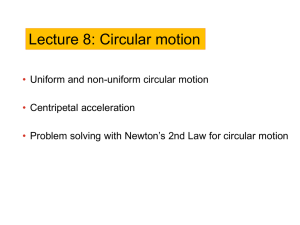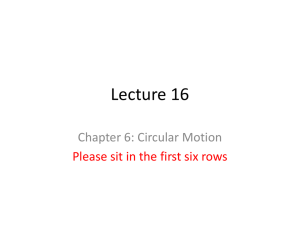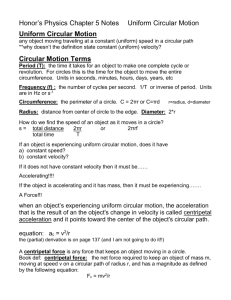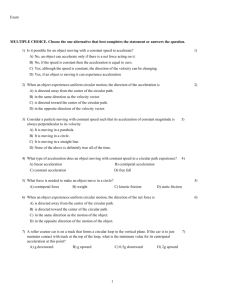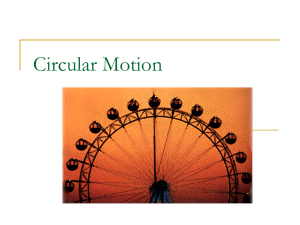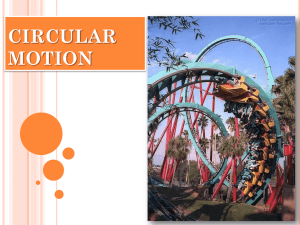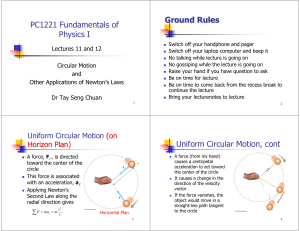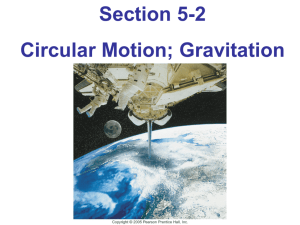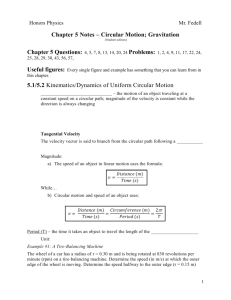Circular Motion
advertisement
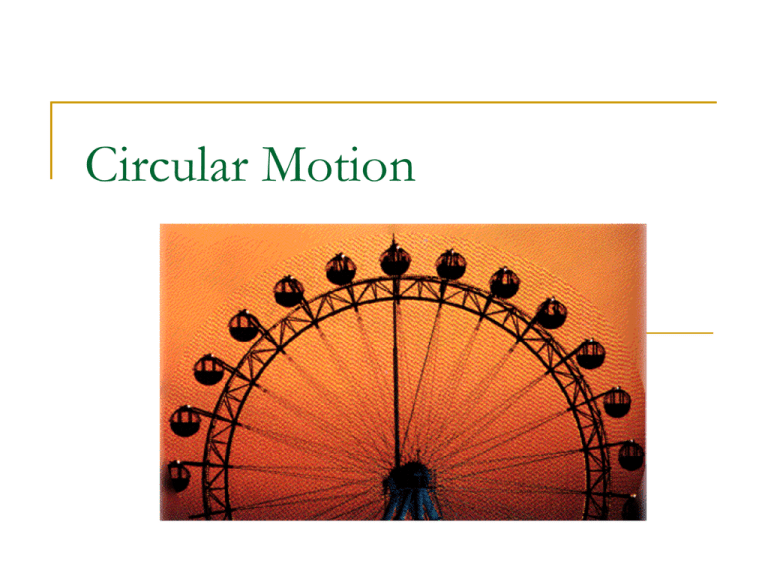
Circular Motion Uniform Circular Motion Speed is constant, VELOCITY is NOT. Direction of the velocity is ALWAYS changing. Period (T) = time to travel around circular path once. (C = 2πr). v d 2r T T We call this velocity, TANGENTIAL velocity as its direction is TANGENT to the circle. Centripetal Acceleration v v θ s q r s v t vt v r v v v v r t 2 v q v 2 v ac r ac centripetal acceleration Centripetal means “center seeking” so that means that the acceleration points towards the CENTER of the circle. Drawing the Directions correctly So for an object traveling in a counter-clockwise path. The velocity would be drawn TANGENT to the circle and the acceleration would be drawn TOWARDS the CENTER. To find the MAGNITUDES of each we have: 2r vt T v2 ac r Circular Motion and N.S.L 2 Recall that according to Newton’s Second Law, the acceleration is directly proportional to the Force. If this is true: v FNET m ac m r 2 mv FNET Fc r Fc Centripetal Force NOTE: The centripetal force is a NET FORCE. It could be represented by one or more forces. So NEVER draw it in an FBD. Examples 2r vt T The blade of a windshield wiper moves through an angle of 90 degrees in 0.28 seconds. The tip of the blade moves on the arc of a circle that has a radius of 0.76m. What is the magnitude of the centripetal acceleration of the tip of the blade? 2 (.76m) vt 4.26 m/s (.28s * 4) v 2 (4.26m/s2 ) 2 ac 23.92 m/s2 r 0.76m Examples Top view What is the minimum coefficient of static friction necessary to allow a penny to rotate along a 33 1/3 rpm record (diameter= 0.300 m), when the penny is placed at the outer edge of the record? F f Fc FN mg Side view Ff m v2 FN r m v2 m g r v2 rg rev 1 min 33.3 * 0.555rev sec min 60 sec 1sec 1.80 sec T rev 0.555 rev 2r 2 (0.15) 0.524 m / s T 1.80 v2 (0.524) 2 0.187 rg (0.15)(9.8) vc Satellites in Circular Orbits Consider a satellite travelling in a circular orbit around Earth. There is only one force acting on the satellite: gravity. Hence, F ma c Fg m ME m v2 G 2 r r mM E Fg G 2 r ME v G r There is only one speed a satellite may have if the satellite is to remain in an orbit with a fixed radius. Examples Venus rotates slowly about its axis, the period being 243 days. The mass of Venus is 4.87 x 1024 kg. Determine the radius for a synchronous satellite in orbit around Venus. (assume circular orbit) Mm m v2 Fg Fc G 2 r r GM 2r v 2 vt r T Fg 2 GM 4 2 r 2 GMT 2 GMT 3 r r3 2 2 r T 4 4 2 11 24 7 2 ( 6 . 67 x 10 )( 4 . 87 x 10 )( 2 . 1 x 10 ) r3 2 4 1.54x109 m Welcome Today, Mr. Souza will give some notes about banked curves and vertical circular motion. You may Sit in the first several rows in order to join the discussion about the above two topics OR Sit towards the back part of the room and begin work on tonight’s homework: C&J p.150 # 21, 24, 26, 35, 36, 37, 40, 42 Banked Curves A car of mass, m, travels around a banked curve of radius r. m v2 Fx r m v2 FN sin q r FN FN cos(θ) θ FN sin(θ) Fy 0 θ W=mg FN cosq m g 2 mv FN sin q r FN cosq mg mg FN cos q 2 v tanθ rg mg cosq sin q mvr 2 Banked Curves Example Design an exit ramp so that cars travelling at 13.4 ms-1 (30.0 mph) will not have to rely on friction to round the curve (r = 50.0 m) without skidding. FN 2 v tanθ rg θ FN cos(θ) FN sin(θ) θ 2 1 2 (13.4m s ) 1 v 1 q tan tan 2 rg (50.0m)(9.80m s ) W=mg q 20.1 Vertical Circular Motion Gratuitous Hart Attack F m v2 NB m g r m v2 NL NR r NT NL mg NR mg NB mv 2 r mg m v2 NT m g r What minimum speed must she have to not fall off at the top? mg Vertical Circular Motion What minimum speed must she have to not fall off at the top? 2 mv NT m g r 2 mv mg r NT mg v rg 2 v rg Examples The maximum tension that a 0.50 m string can tolerate is 14 N. A 0.25-kg ball attached to this string is being whirled in a vertical circle. What is the maximum speed the ball can have (a) at the top of the circle, and (b)at the bottom of the circle? (a) FNET Fc m v2 T mg r r (T mg ) v 2 m r v (T m g) m v T mg v 5.74 m s-1 0.50m (14N (0.25kg)(9.8m s-2 )) 0.25kg Examples (b) At the bottom? FNET Fc m v2 T mg r r (T mg ) v 2 m v r (T m g) m v 0.50m (14N (0.25kg)(9.8m s-2 )) 0.25kg T mg v 4.81 m s -1 Homework C&J p.150 # 21, 24, 26, 35, 36, 37, 40, 42 Please watch these two video clips (they relate to problem #37). http://www.youtube.com/watch?v=v1VrkWb0l2M http://www.youtube.com/watch?v=2V9h42yspbo Homework problems and links to video clips will be posted on Mr. Souza’s ASD site.
